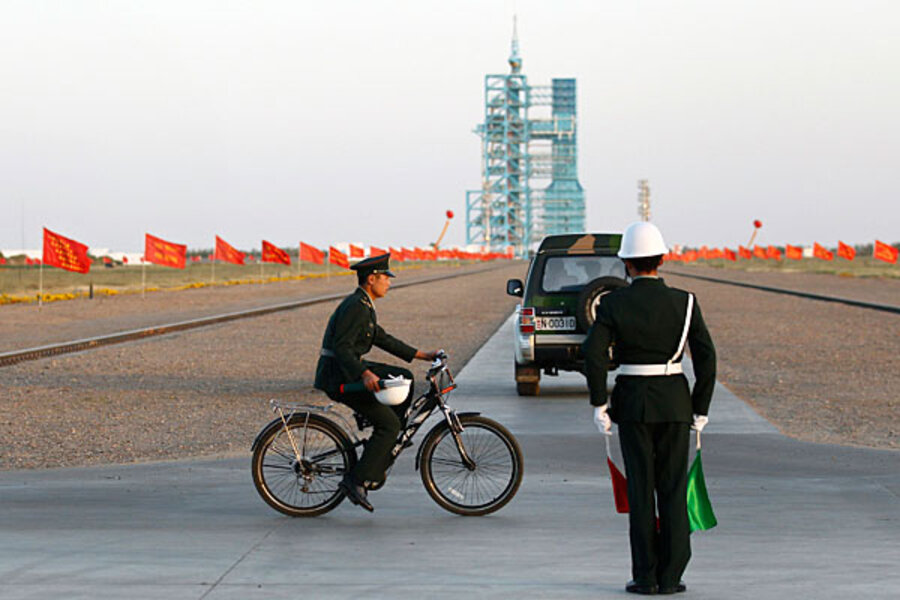Could China's first 'space kiss' lead to a Mars mission with US?
Loading...
Two unmanned spacecraft successfully docked in what many Chinese call their space program's first "space kiss" early Thursday morning, Beijing time.
The docking between a prototype space-station module, Tiangong 1, and an unmanned Shenzhou crew capsule heralds another significant step forward for China's human-spaceflight program.
Rendezvous and docking while circling the globe once every 90 minutes is a challenging feat, aerospace engineerings say, even though over the past 40 years the US, Russia, and more recently Europe and Japan have made it look routine.
Now that China has demonstrated the capability as well, it has cleared a significant technological hurdle on the path toward building, staffing, and resupplying a space station – a facility the country hopes to place on orbit by the early 2020s.
"It's a significant achievement for China to develop this capability," said John Logsdon, founder and former director of the Space Policy Institute at George Washington University in Washington, D.C., in an interview with China's CNTV.
But it has to be seen in perspective, he added, noting that the event marked the second robotic docking of the day. Earlier, a Russian Progress resupply ship preformed an automated docking with the International Space Station.
Still, the ability to dock "is something that is essential for space operations and China, which has ambitions to have a comprehensive space program, needs to acquire this technology."
The docking, which took place at 1:30 p.m. Eastern Daylight Time today, earned the team of engineers and controllers behind the mission a congratulatory letter from Chinese President Hu Jintao, who is in Cannes, France, for the G-20 economic summit. [Editor's note: The original misstated the location of the G-20 summit.]
After noting the event's significance, he added, "I hope all of the personnel involved in this will continue their efforts in a united way to make the whole mission a complete success."
As the Chinese human spaceflight program has progressed, several space-policy analysts have suggested that the technical skills China is building bodes well for future cooperation in international spaceflight efforts. It means China has a proven set of technical skills to bring to the table.
During congressional hearings last May, John Holdren, President Obama's science advisor, noted that China is expected to host the world's largest economy by 2030 – about the time various US plans for human space exploration have envisioned the first manned mission to Mars.
Estimates have put the cost of such a venture in the $100 billion to $200 billion range – an amount many say is too high for a single country or space program to afford.
For officials in the White House and at NASA, Dr. Holdren told lawmakers, "it's not too soon to have preliminary conversations about what involving China in that sort of cooperation might entail ... It could certainly be to our benefit to share the costs of such an expensive venture with them and with others."
But while cooperation may be an idea politicians kick around, China's aerospace community probably would see such a move as a distraction, says Gregory Kulacki, a senior analyst who focuses on China for the Union of Concerned Scientists' global-security program.
Dr. Kulacki, who travels to China frequently and was in Beijing during Wednesday's docking, notes that while an independent docking capability could help open doors for Chinese participation in international manned missions, it also allows the Chinese to go it alone.
Indeed, he says, it's not clear that the Chinese are interested in cooperation, at least for now. The country has been methodically pursuing a program for orbiting a space station and has another 10 years to go. They intend to see the effort through.
"They are so far along with a plan they first conceived back in the mid 1980s, and they are so close to accomplishing the goals set out, that international cooperation for the Chinese human spaceflight program at this point is nothing but a distraction," he says.
For now, the Chinese have a full platter in seeing the current mission through.
The two craft will remain docked for 12 days as engineers verify that Tiangong 1 is able to control the mated pair, according to Yang Yuguang, who heads the China Aerospace, Science, and Industry Corporation.
Mission controllers plan to undock the Shenzhou 8 capsule, back it off about 150 feet, then have it dock again with Tiangong 1 as a second test of the docking system. Two days later, Shenzhou 8 will undock for a return to Earth.
Although Tiangong 1 is a technology test bed for future space-station modules, China's space program says the craft also will serve as the basis for an unmanned resupply craft that will service the country's space station.





